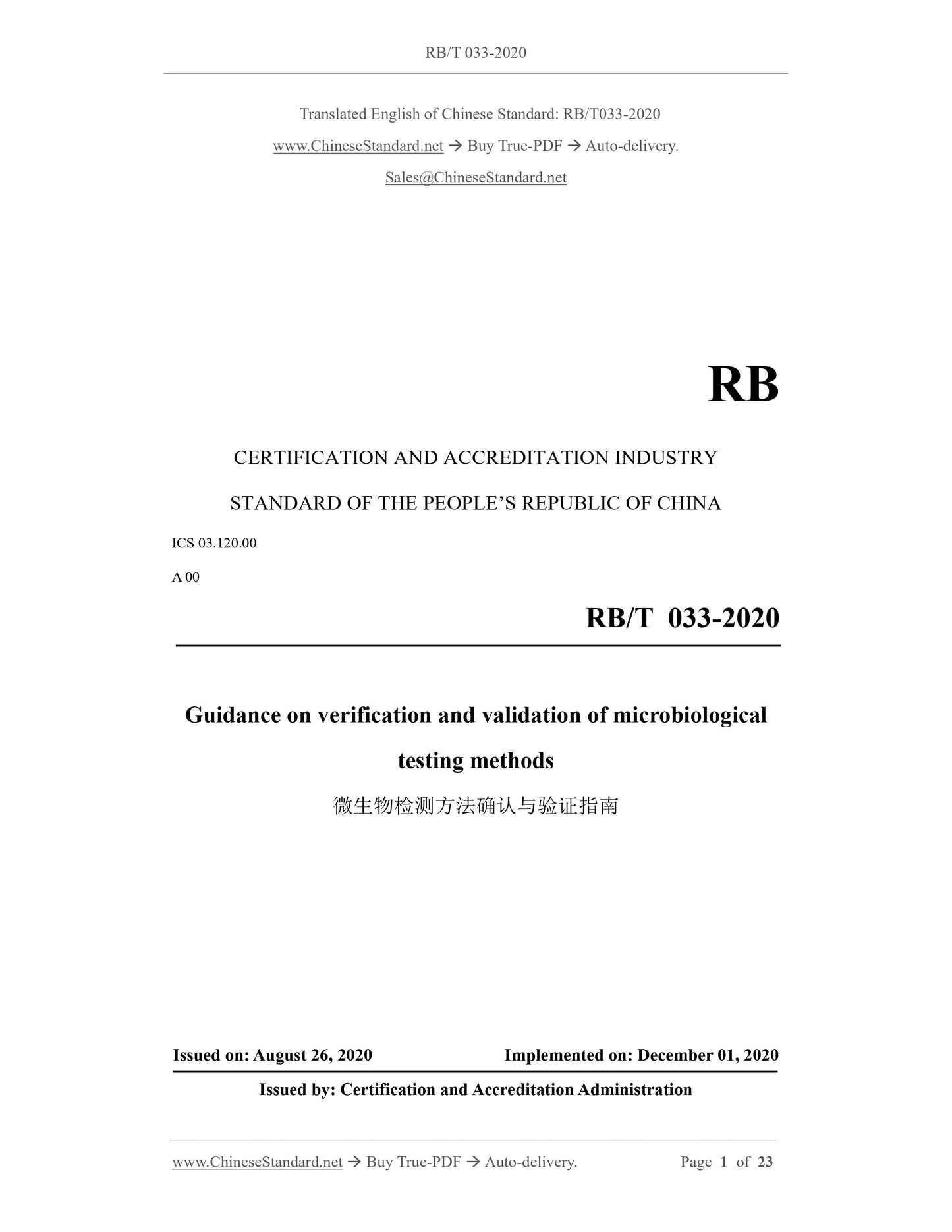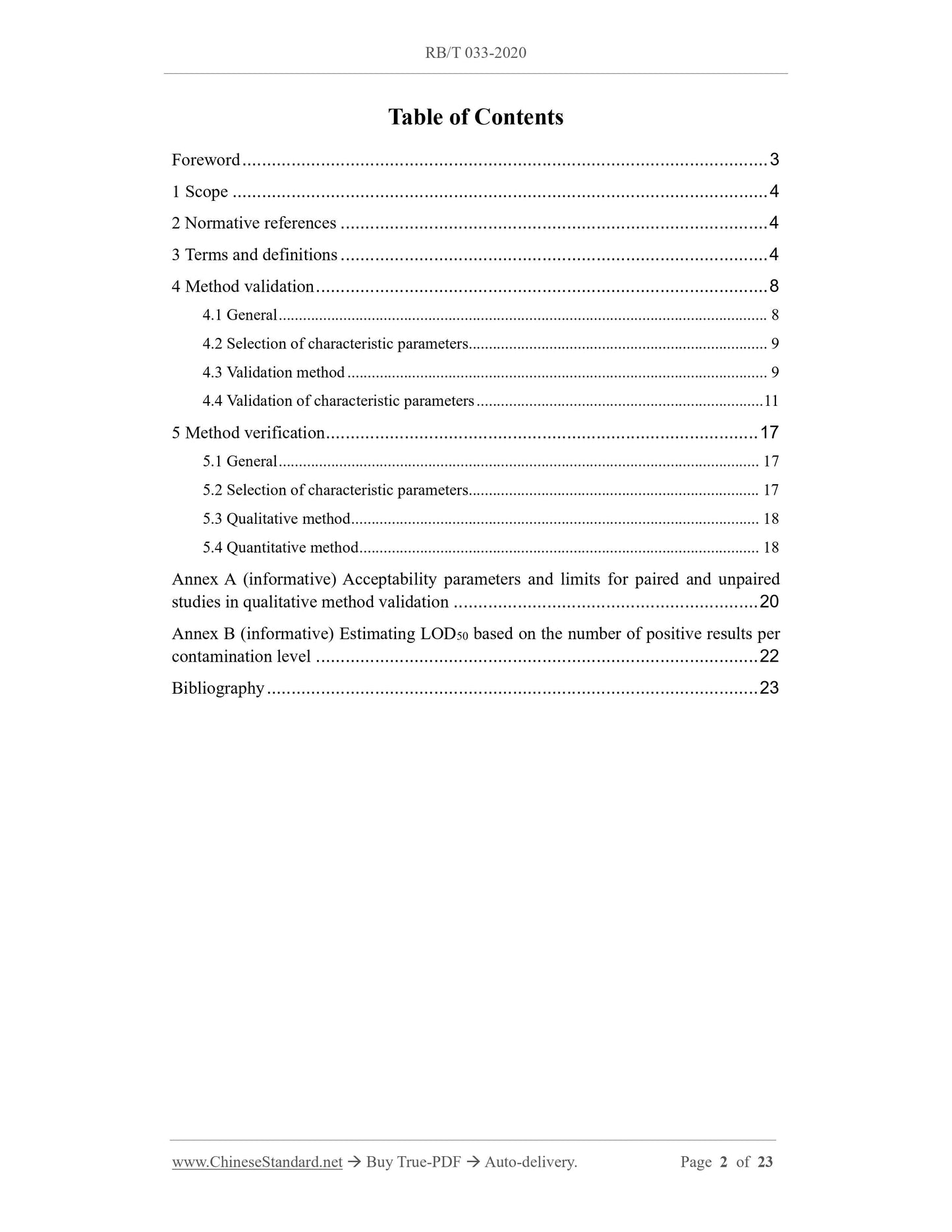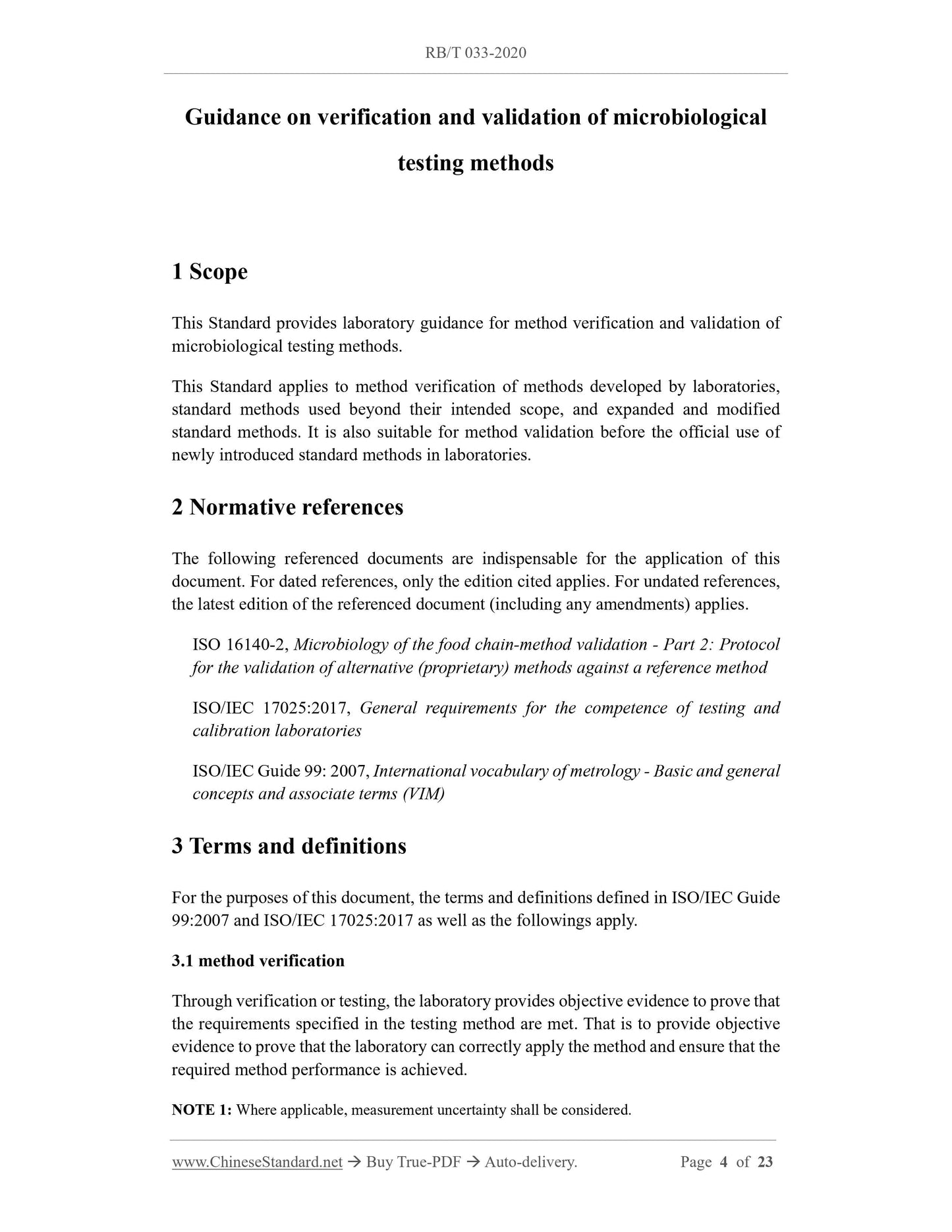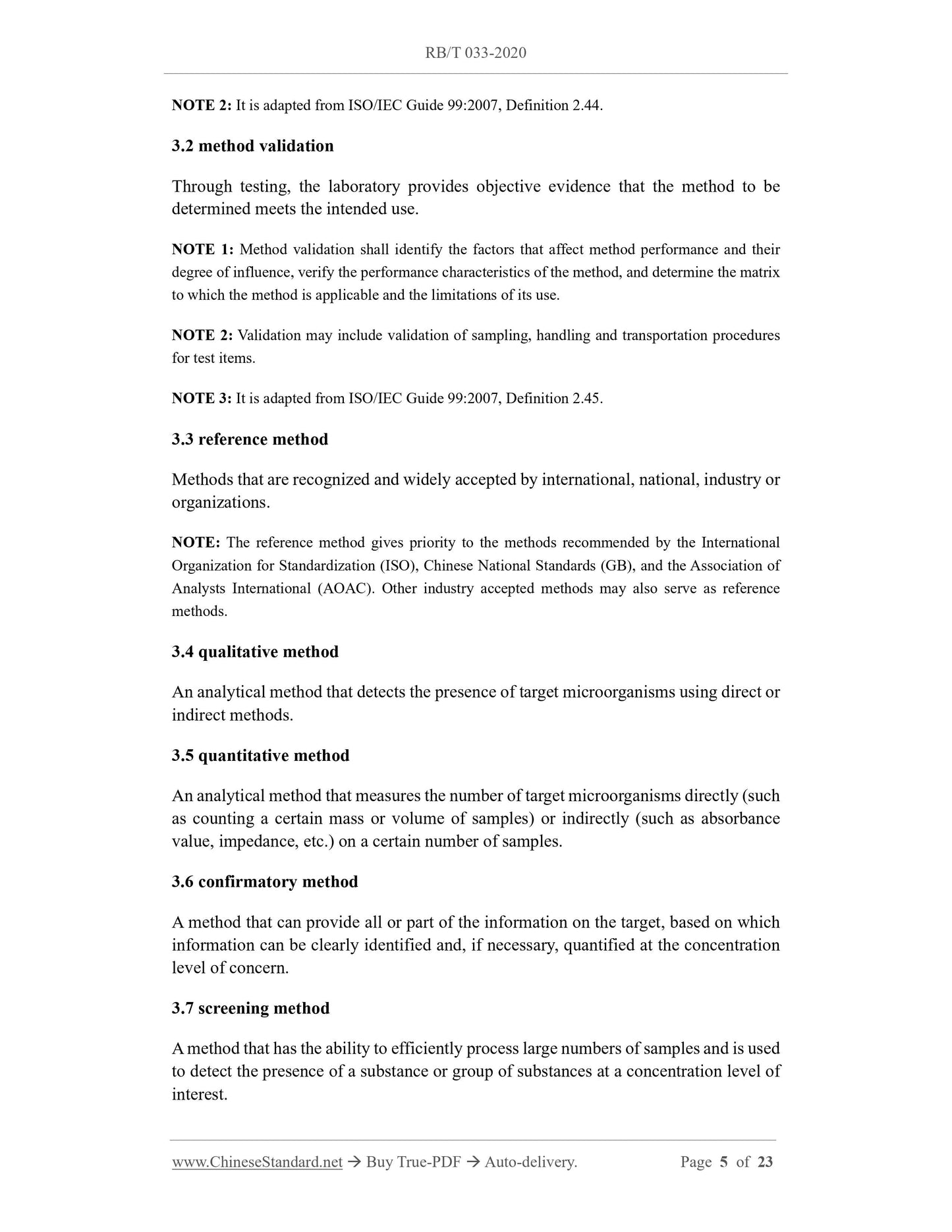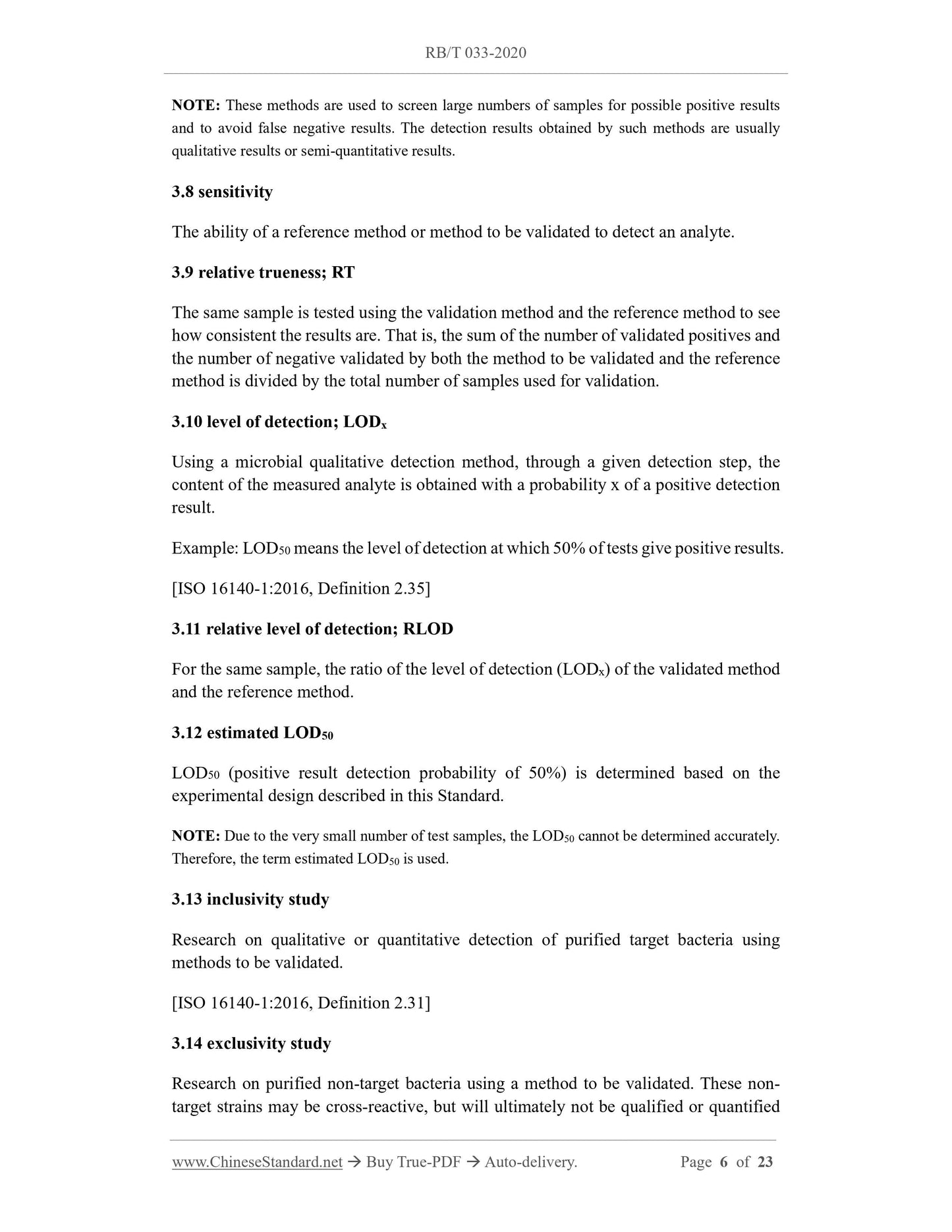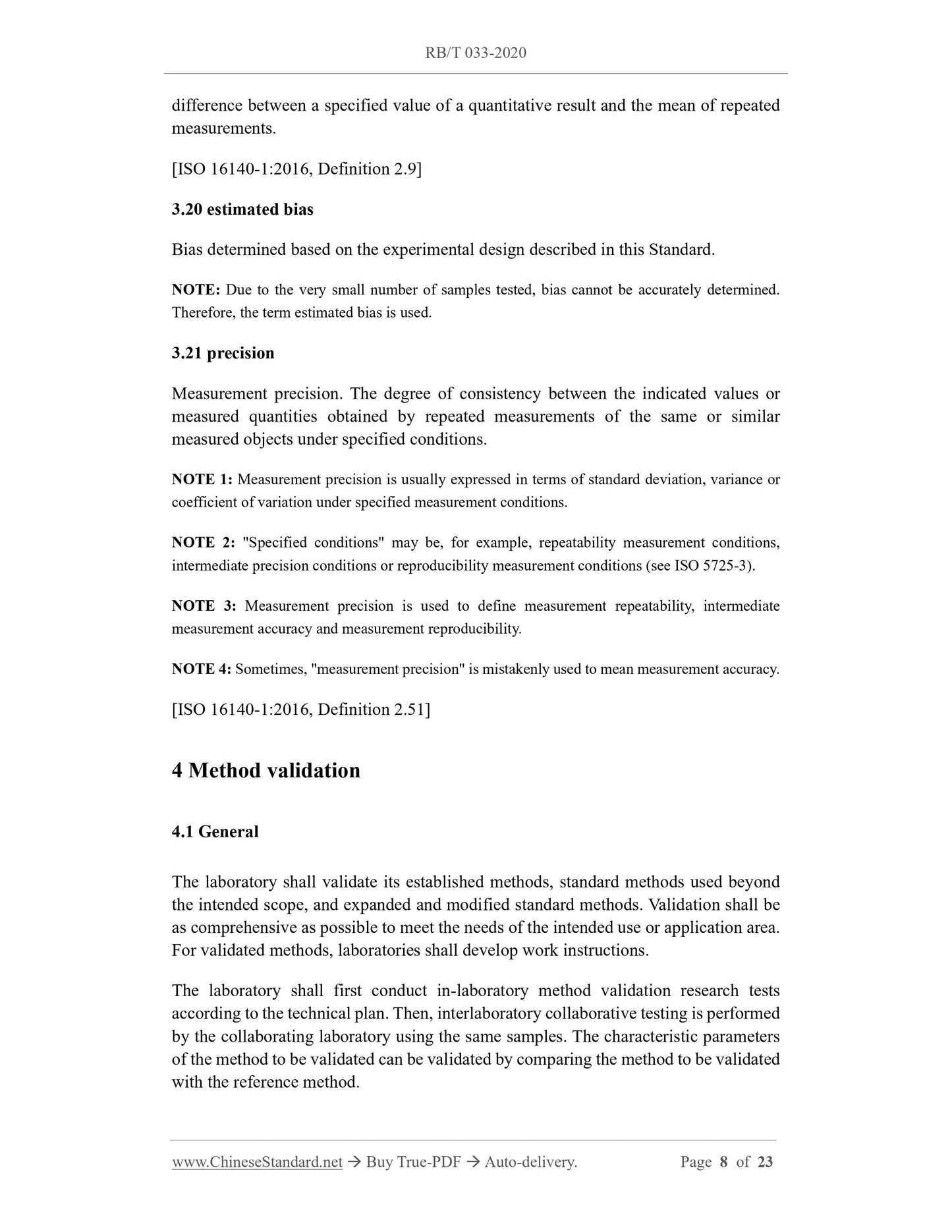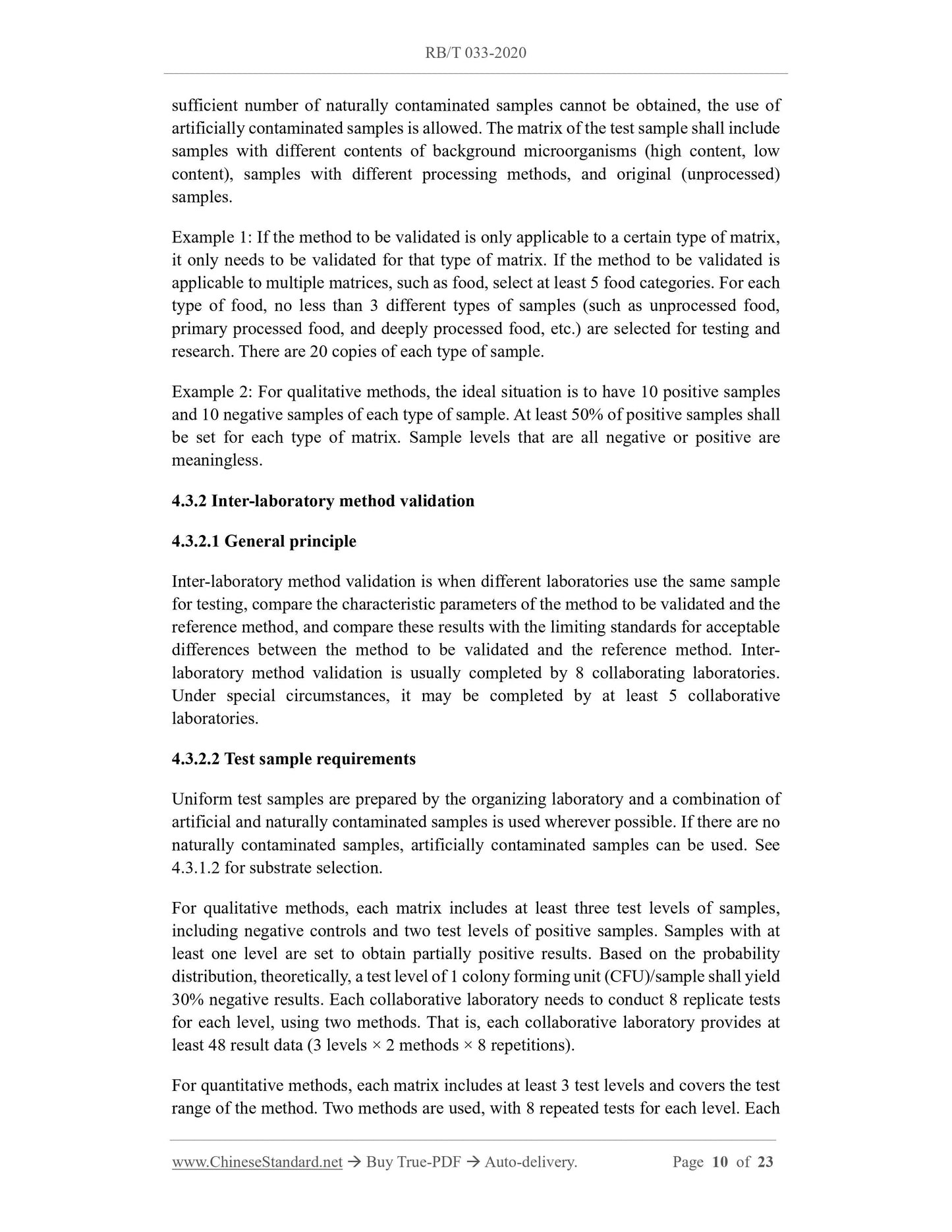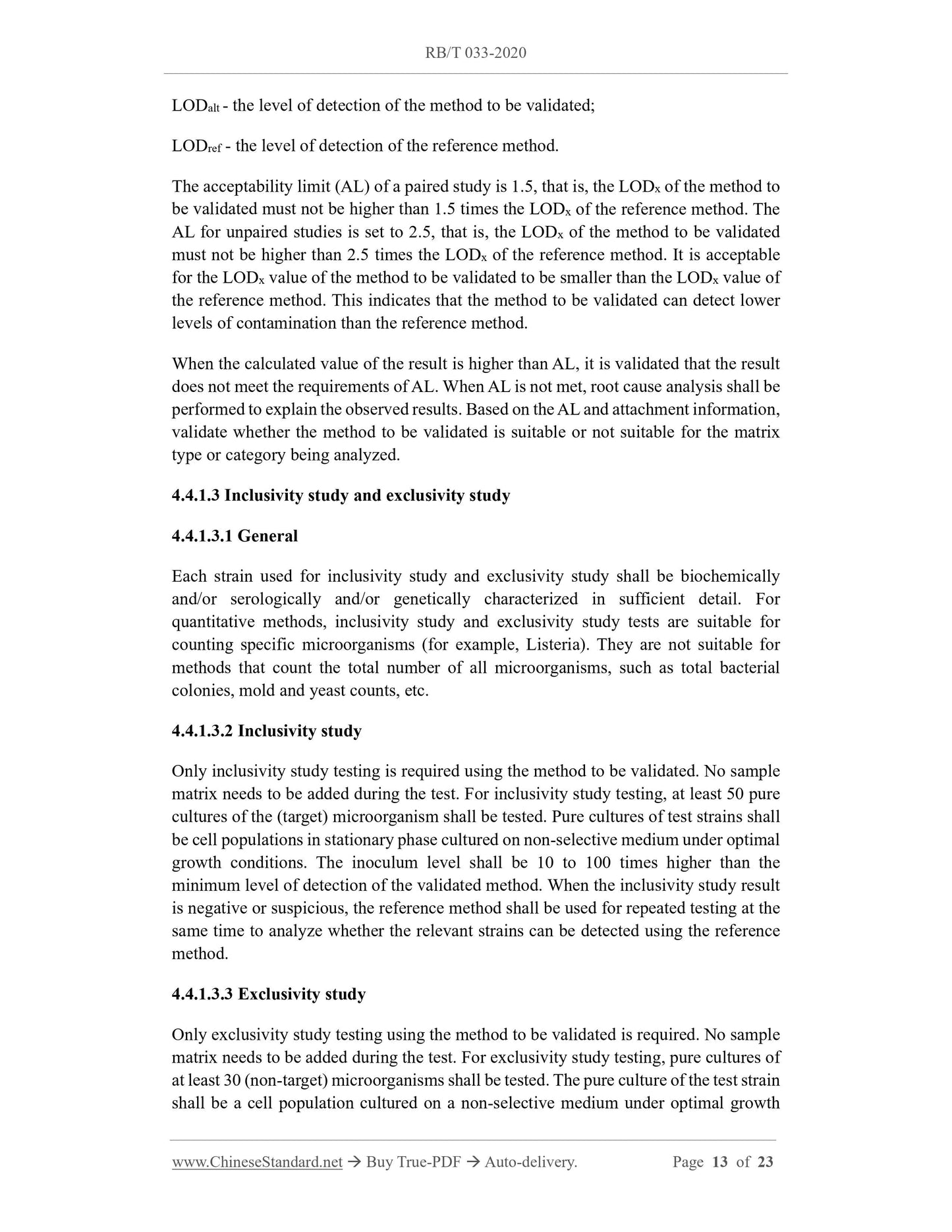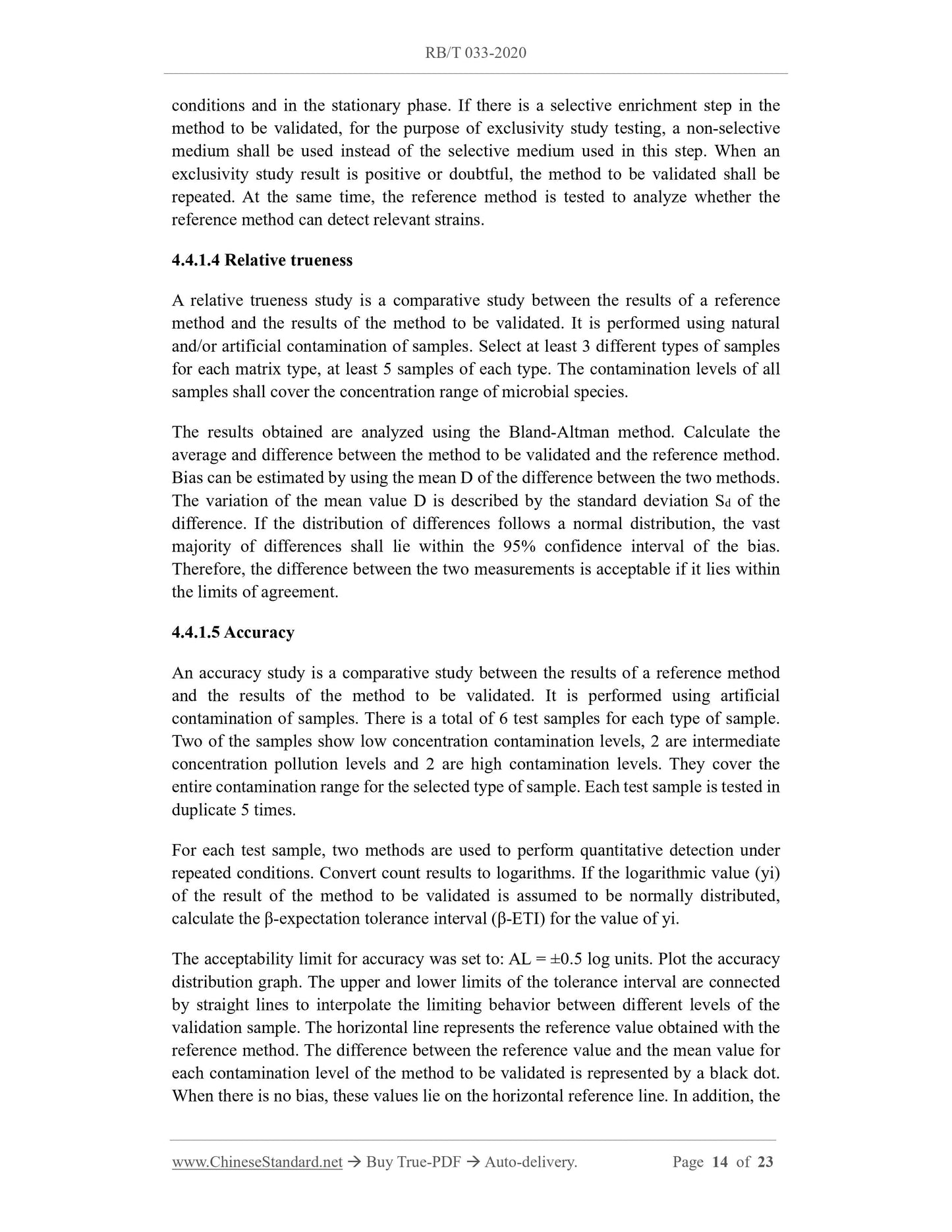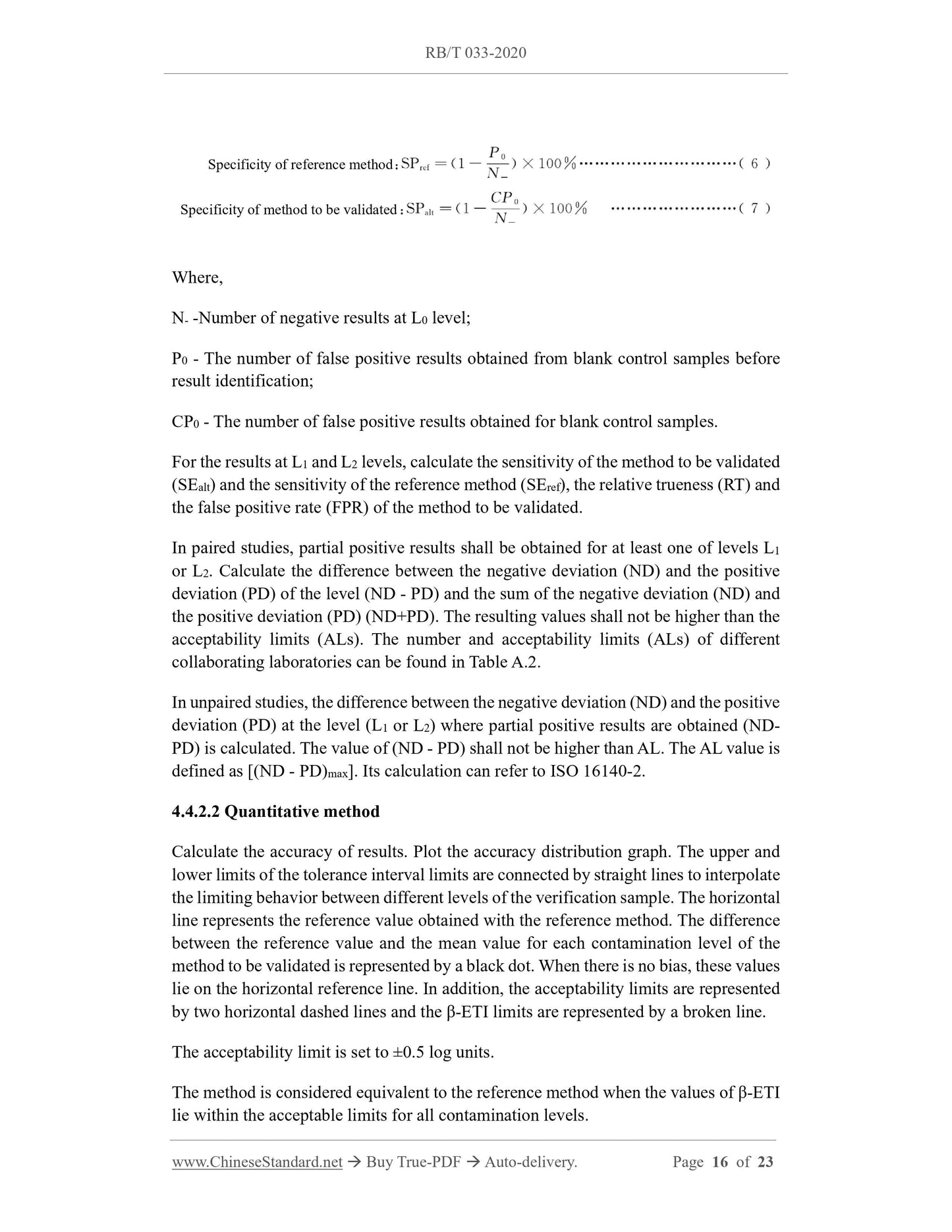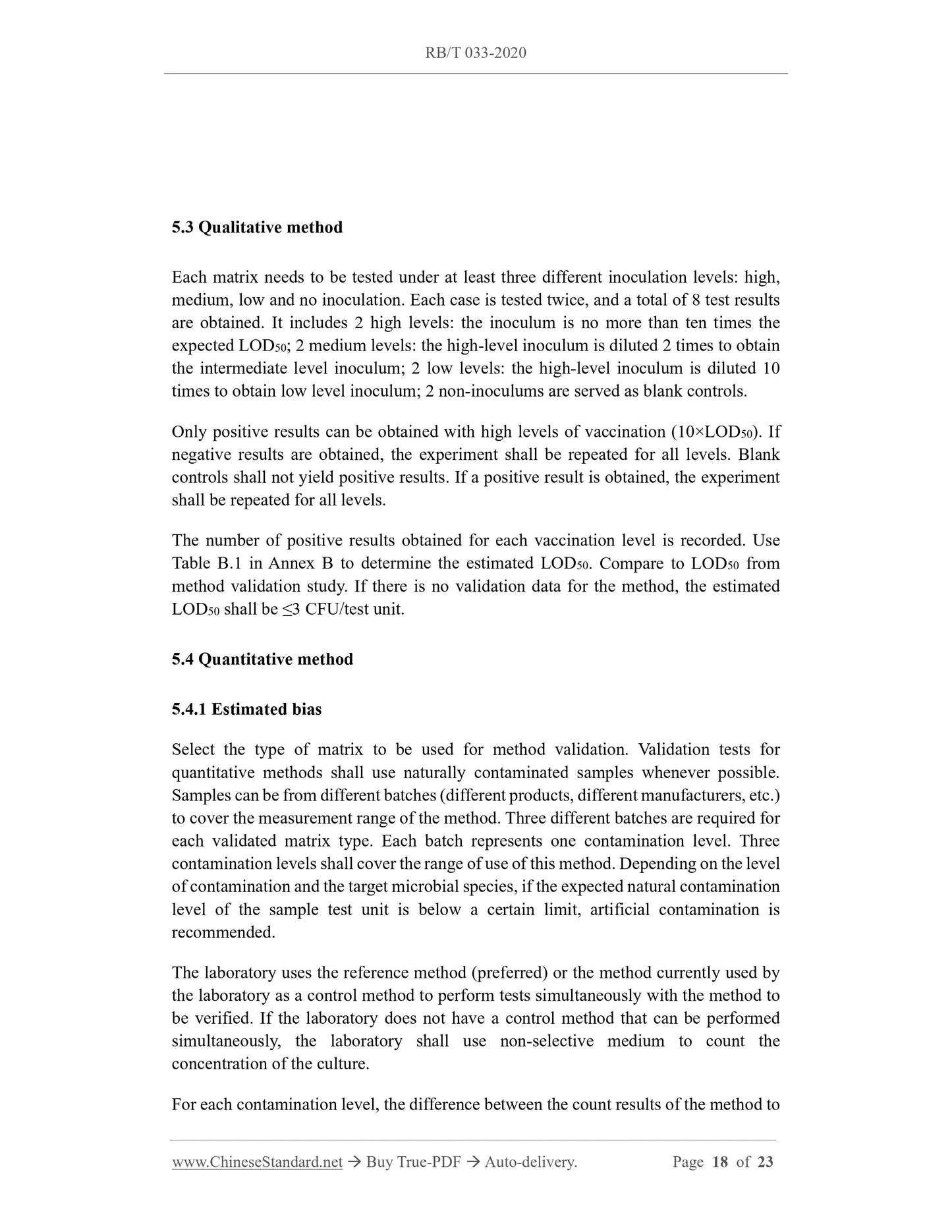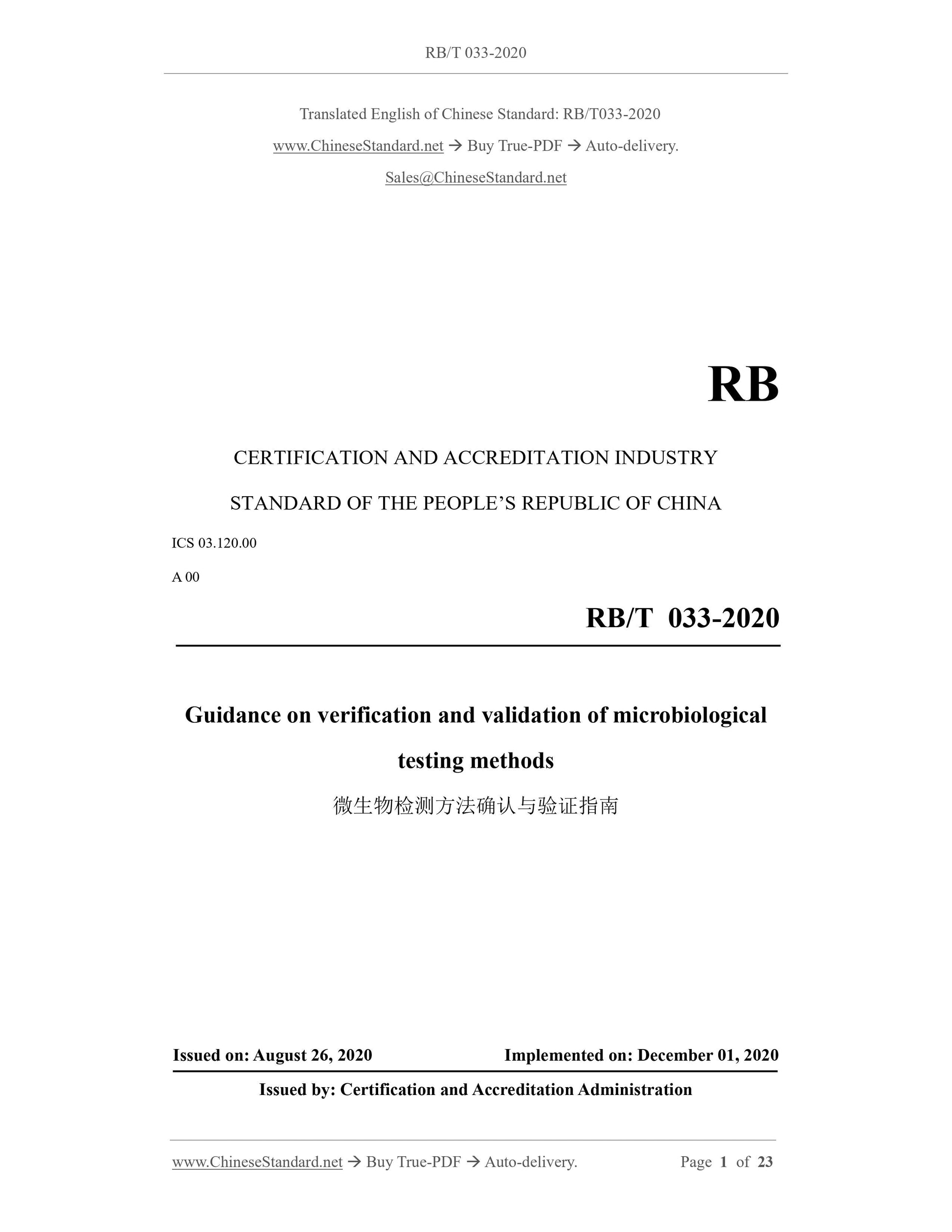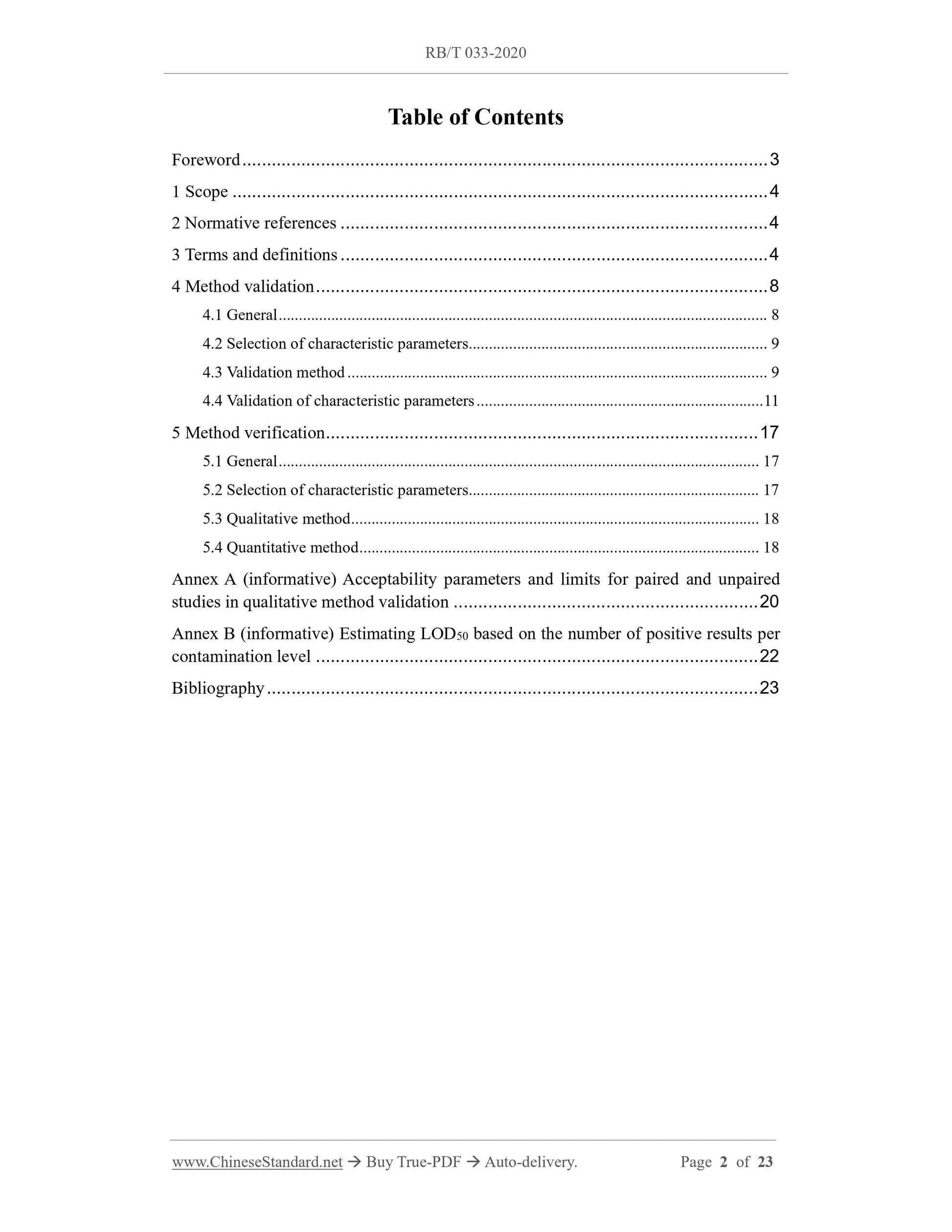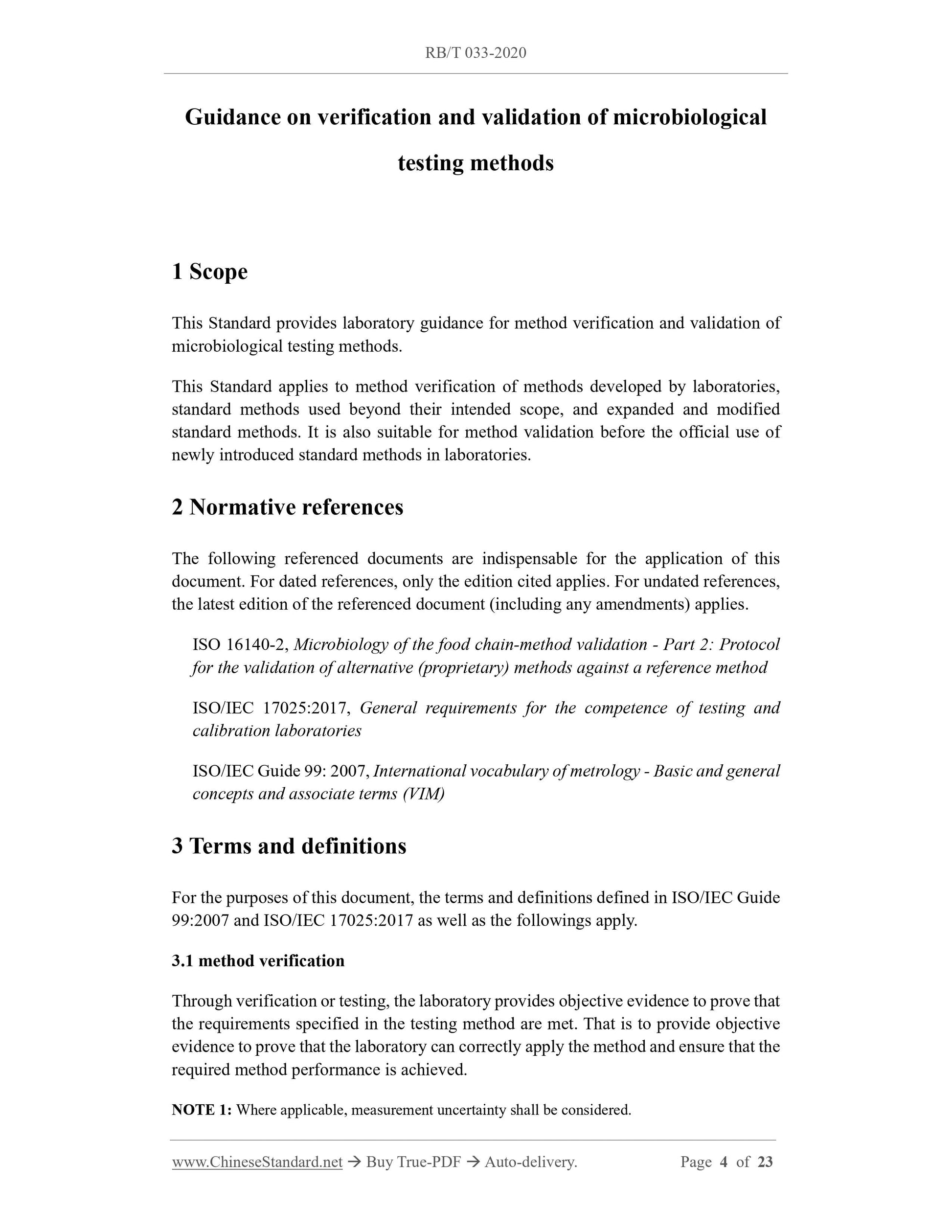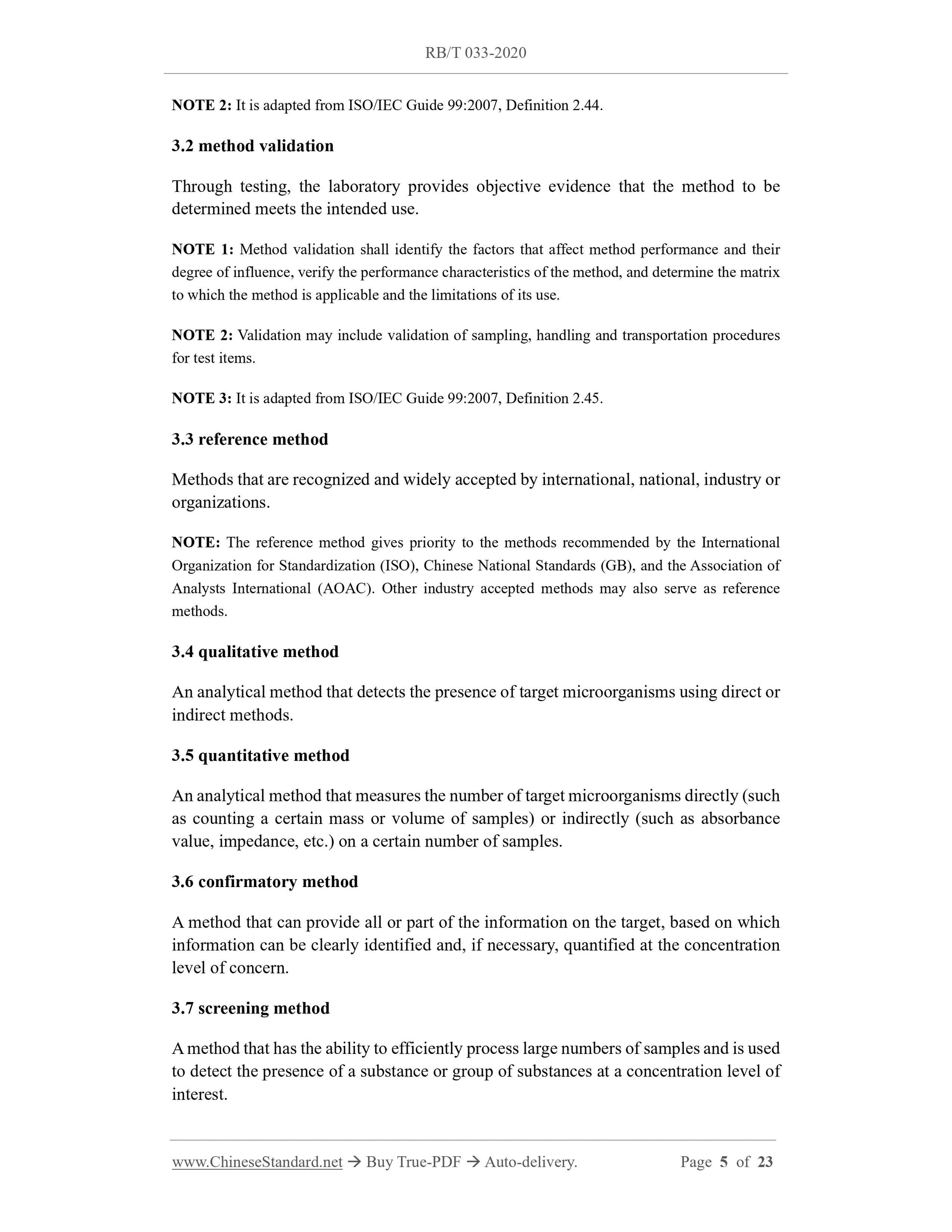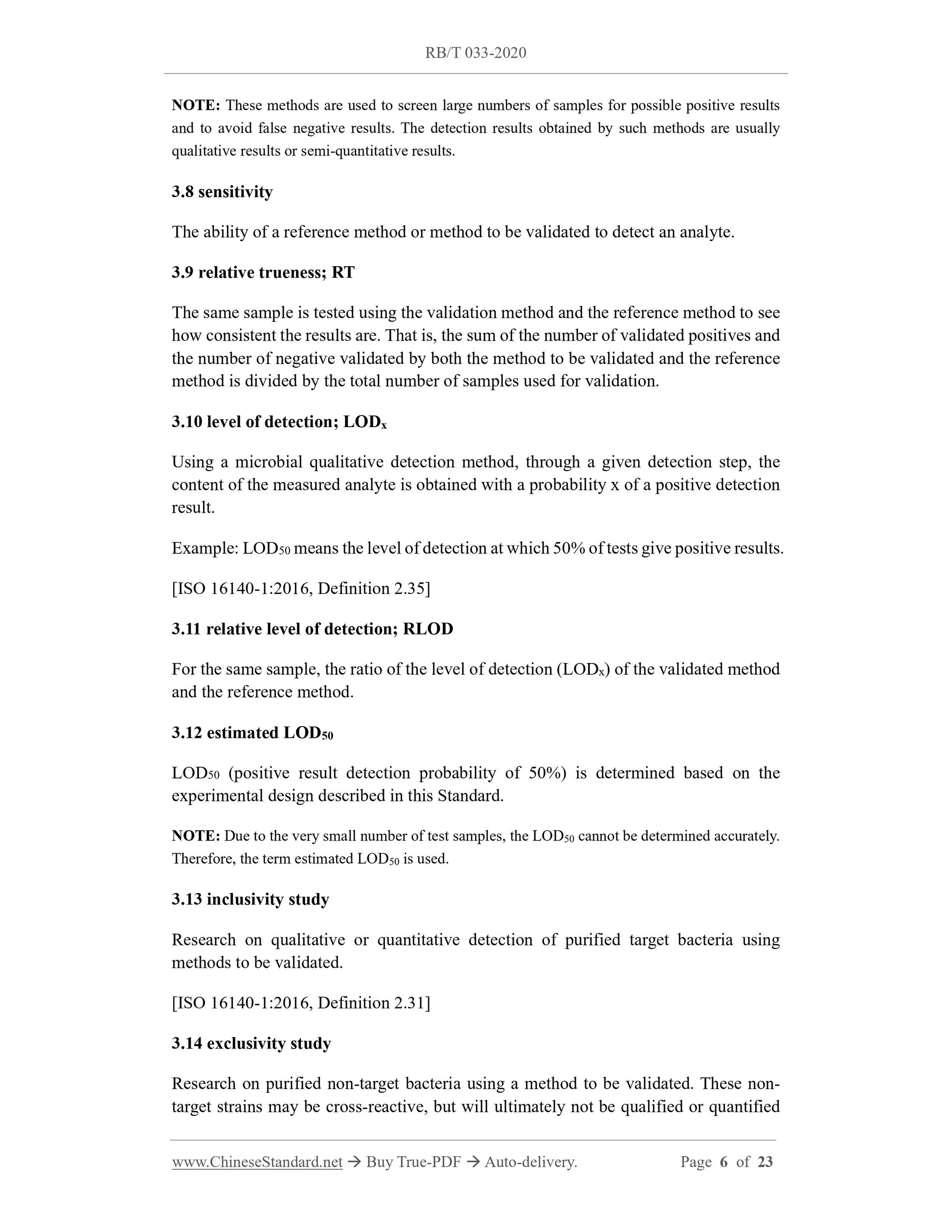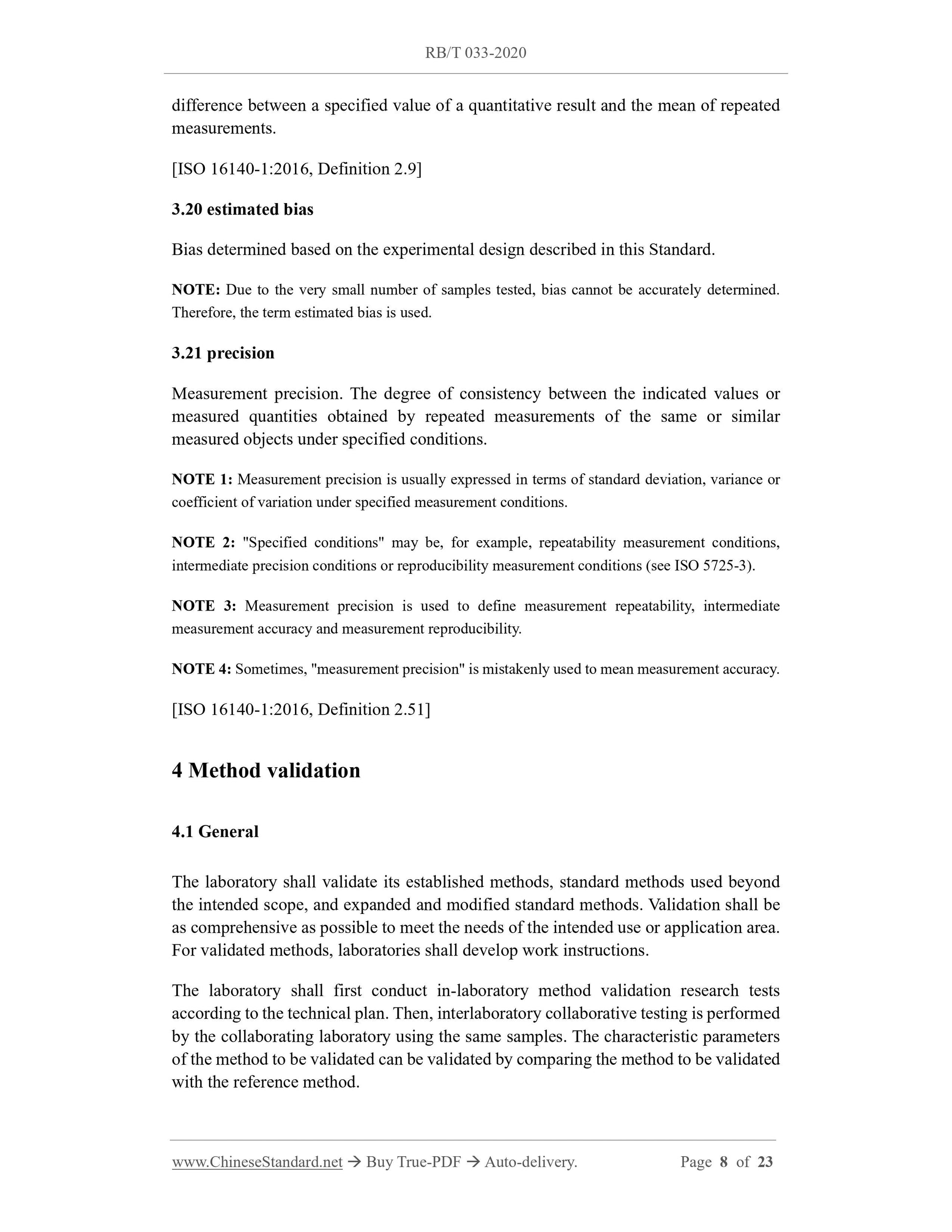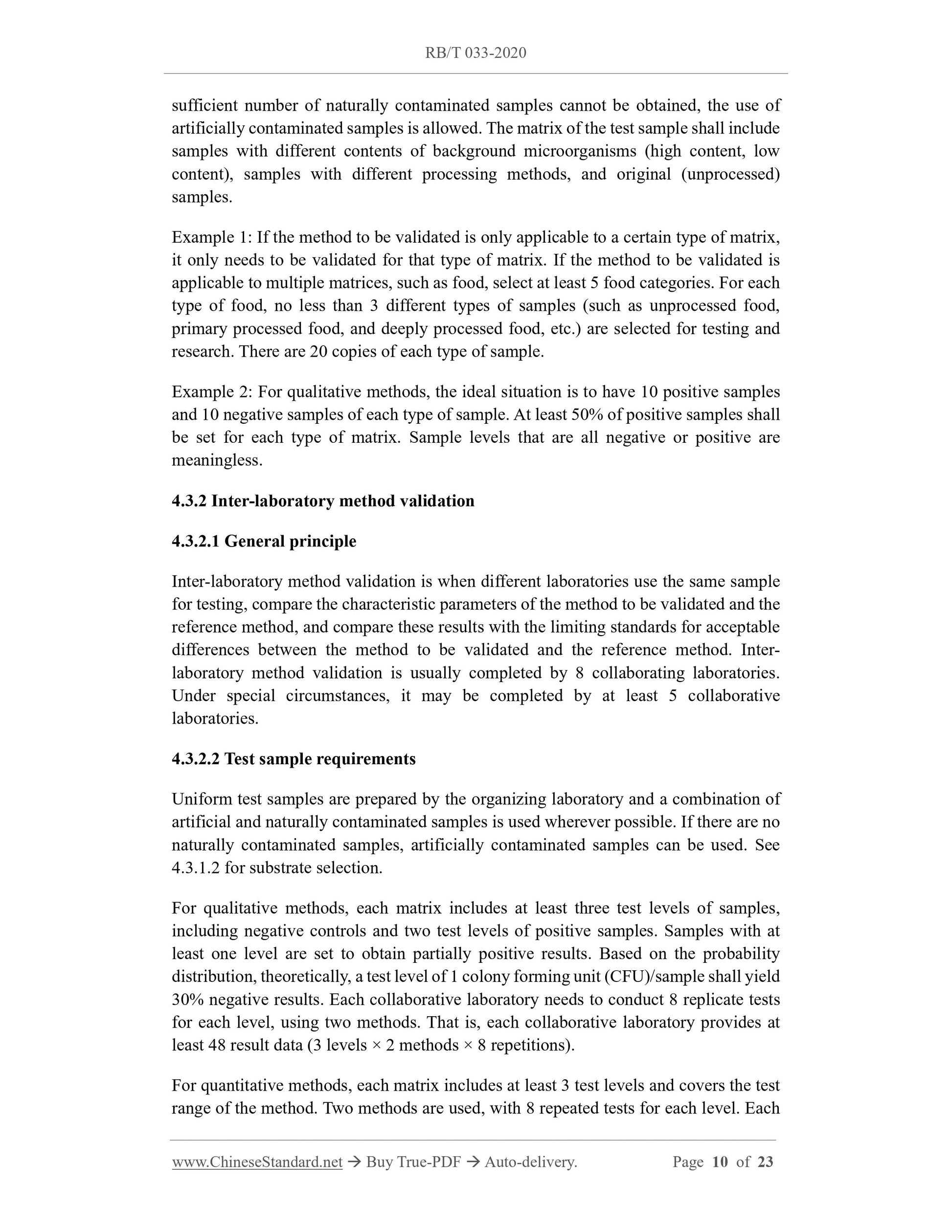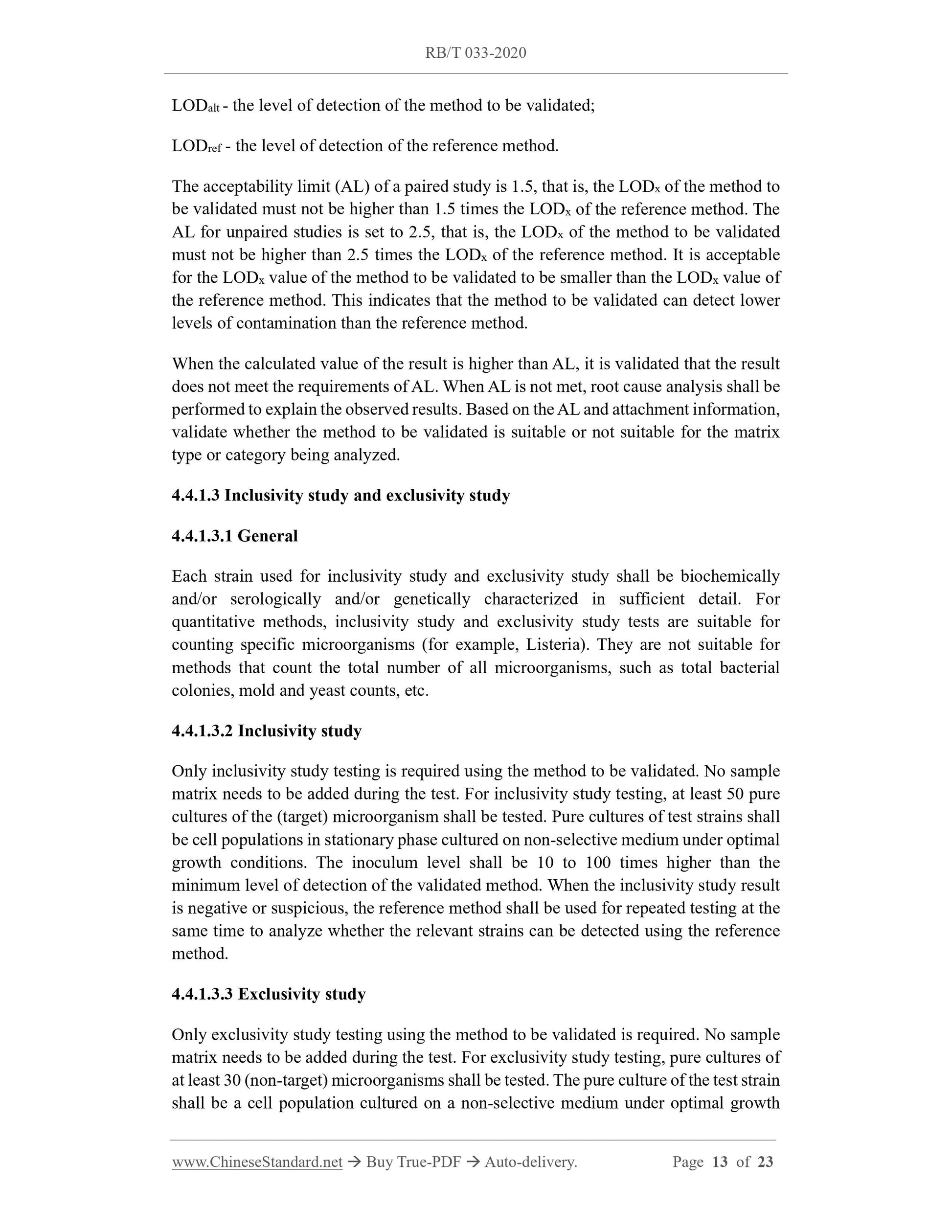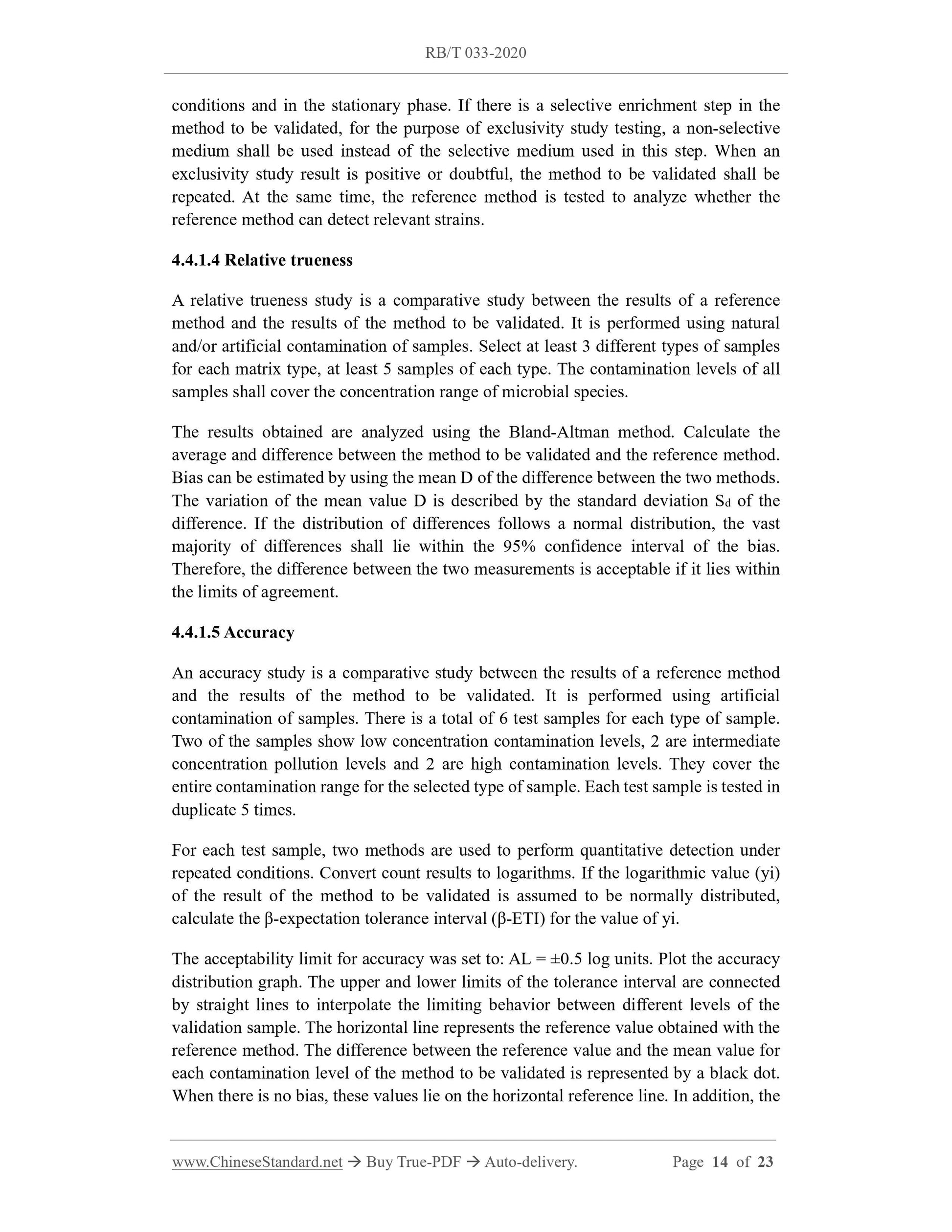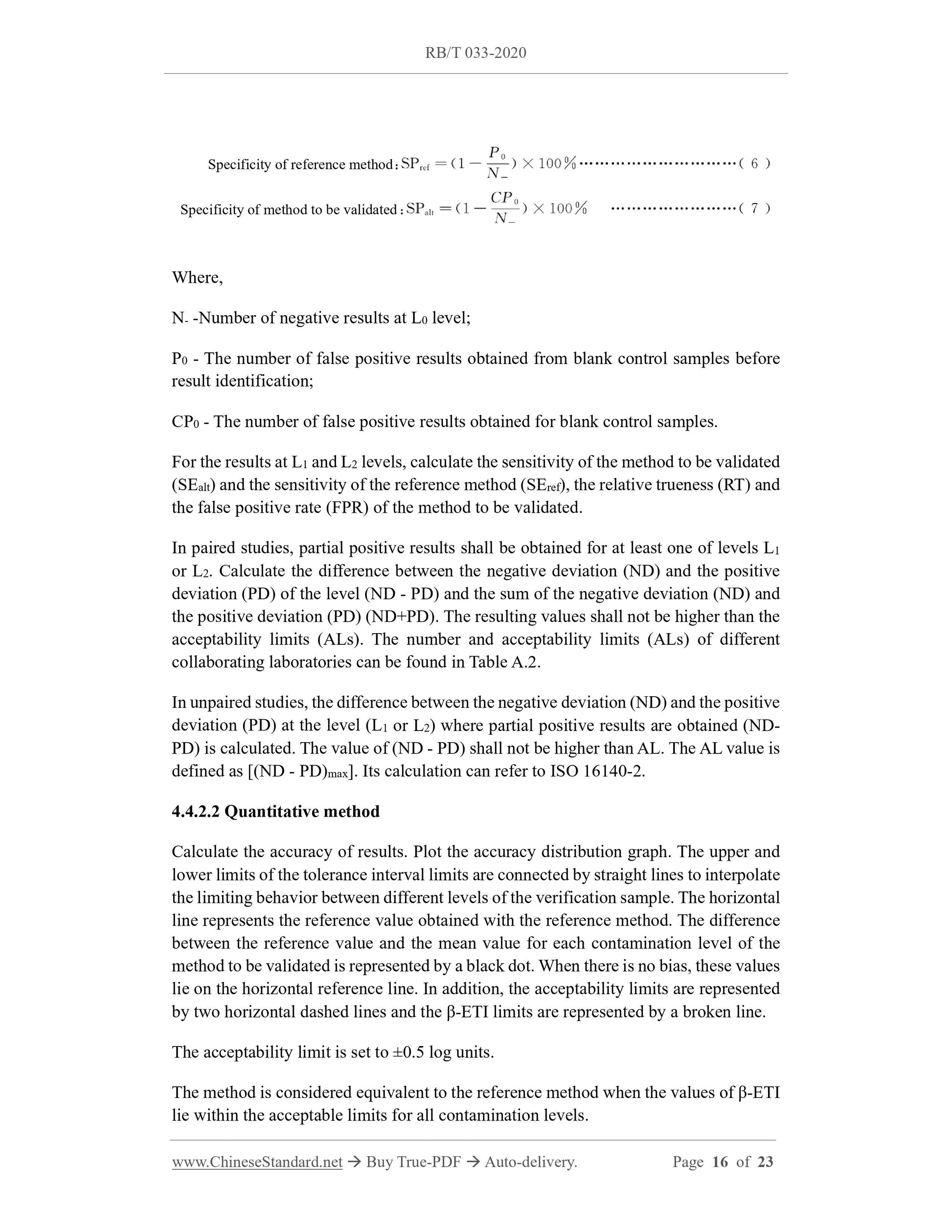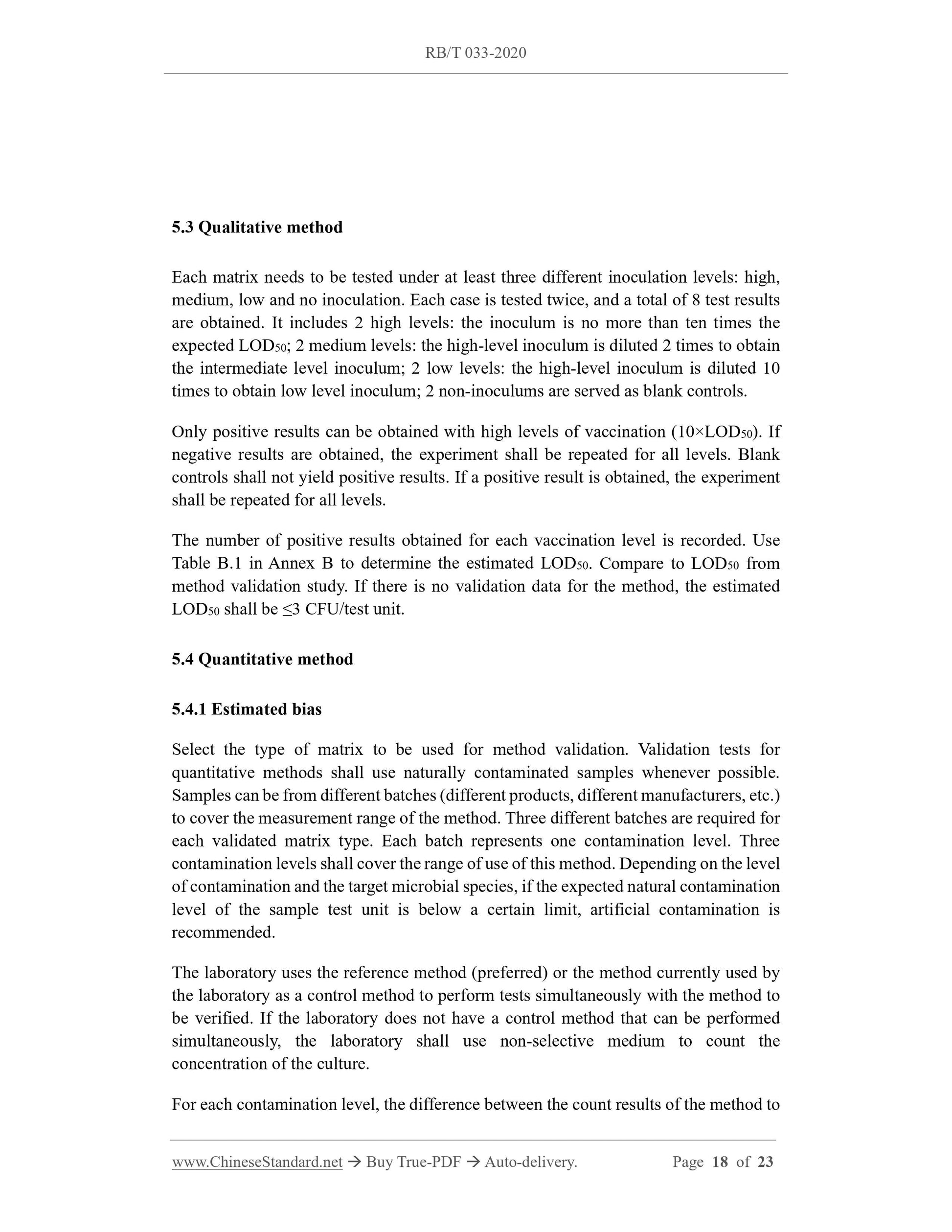1
/
of
11
www.ChineseStandard.us -- Field Test Asia Pte. Ltd.
RB/T 033-2020 English PDF (RB/T033-2020)
RB/T 033-2020 English PDF (RB/T033-2020)
Regular price
$360.00
Regular price
Sale price
$360.00
Unit price
/
per
Shipping calculated at checkout.
Couldn't load pickup availability
RB/T 033-2020: Guidance on verification and validation of microbiological testing methods
Delivery: 9 seconds. Download (& Email) true-PDF + Invoice.
Get Quotation: Click RB/T 033-2020 (Self-service in 1-minute)
Historical versions (Master-website): RB/T 033-2020
Preview True-PDF (Reload/Scroll-down if blank)
RB/T 033-2020
RB
CERTIFICATION AND ACCREDITATION INDUSTRY
STANDARD OF THE PEOPLE’S REPUBLIC OF CHINA
ICS 03.120.00
A 00
Guidance on verification and validation of microbiological
testing methods
ISSUED ON: AUGUST 26, 2020
IMPLEMENTED ON: DECEMBER 01, 2020
Issued by: Certification and Accreditation Administration
Table of Contents
Foreword ... 3
1 Scope ... 4
2 Normative references ... 4
3 Terms and definitions ... 4
4 Method validation ... 8
4.1 General ... 8
4.2 Selection of characteristic parameters... 9
4.3 Validation method ... 9
4.4 Validation of characteristic parameters ... 11
5 Method verification ... 17
5.1 General ... 17
5.2 Selection of characteristic parameters... 17
5.3 Qualitative method ... 18
5.4 Quantitative method ... 18
Annex A (informative) Acceptability parameters and limits for paired and unpaired
studies in qualitative method validation ... 20
Annex B (informative) Estimating LOD50 based on the number of positive results per
contamination level ... 22
Bibliography ... 23
Guidance on verification and validation of microbiological
testing methods
1 Scope
This Standard provides laboratory guidance for method verification and validation of
microbiological testing methods.
This Standard applies to method verification of methods developed by laboratories,
standard methods used beyond their intended scope, and expanded and modified
standard methods. It is also suitable for method validation before the official use of
newly introduced standard methods in laboratories.
2 Normative references
The following referenced documents are indispensable for the application of this
document. For dated references, only the edition cited applies. For undated references,
the latest edition of the referenced document (including any amendments) applies.
ISO 16140-2, Microbiology of the food chain-method validation - Part 2: Protocol
for the validation of alternative (proprietary) methods against a reference method
ISO/IEC 17025:2017, General requirements for the competence of testing and
calibration laboratories
ISO/IEC Guide 99: 2007, International vocabulary of metrology - Basic and general
concepts and associate terms (VIM)
3 Terms and definitions
For the purposes of this document, the terms and definitions defined in ISO/IEC Guide
99:2007 and ISO/IEC 17025:2017 as well as the followings apply.
3.1 method verification
Through verification or testing, the laboratory provides objective evidence to prove that
the requirements specified in the testing method are met. That is to provide objective
evidence to prove that the laboratory can correctly apply the method and ensure that the
required method performance is achieved.
NOTE 1: Where applicable, measurement uncertainty shall be considered.
NOTE 2: It is adapted from ISO/IEC Guide 99:2007, Definition 2.44.
3.2 method validation
Through testing, the laboratory provides objective evidence that the method to be
determined meets the intended use.
NOTE 1: Method validation shall identify the factors that affect method performance and their
degree of influence, verify the performance characteristics of the method, and determine the matrix
to which the method is applicable and the limitations of its use.
NOTE 2: Validation may include validation of sampling, handling and transportation procedures
for test items.
NOTE 3: It is adapted from ISO/IEC Guide 99:2007, Definition 2.45.
3.3 reference method
Methods that are recognized and widely accepted by international, national, industry or
organizations.
NOTE: The reference method gives priority to the methods recommended by the International
Organization for Standardization (ISO), Chinese National Standards (GB), and the Association of
Analysts International (AOAC). Other industry accepted methods may also serve as reference
methods.
3.4 qualitative method
An analytical method that detects the presence of target microorganisms using direct or
indirect methods.
3.5 quantitative method
An analytical method that measures the number of target microorganisms directly (such
as counting a certain mass or volume of samples) or indirectly (such as absorbance
value, impedance, etc.) on a certain number of samples.
3.6 confirmatory method
A method that can provide all or part of the information on the target, based on which
information can be clearly identified and, if necessary, quantified at the concentration
level of concern.
3.7 screening method
A method that has the ability to efficiently process large numbers of samples and is used
to detect the presence of a substance or group of substances at a concentration level of
interest.
NOTE: These methods are used to screen large numbers of samples for possible positive results
and to avoid false negative results. The detection results obtained by such methods are usually
qualitative results or semi-quantitative results.
3.8 sensitivity
The ability of a reference method or method to be validated to detect an analyte.
3.9 relative trueness; RT
The same sample is tested using the validation method and the reference method to see
how consistent the results are. That is, the sum of the number of validated positives and
the number of negative validated by both the method to be validated and the reference
method is divided by the total number of samples used for validation.
3.10 level of detection; LODx
Using a microbial qualitative detection method, through a given detection step, the
content of the measured analyte is obtained with a probability x of a positive detection
result.
Example: LOD50 means the level of detection at which 50% of tests give positive results.
[ISO 16140-1:2016, Definition 2.35]
3.11 relative level of detection; RLOD
For the same sample, the ratio of the level of detection (LODx) of the validated method
and the reference method.
3.12 estimated LOD50
LOD50 (positive result detection probability of 50%) is determined based on the
experimental design described in this Standard.
NOTE: Due to the very small number of test samples, the LOD50 cannot be determined accurately.
Therefore, the term estimated LOD50 is used.
3.13 inclusivity study
Research on qualitative or quantitative detection of purified target bacteria using
methods to be validated.
[ISO 16140-1:2016, Definition 2.31]
3.14 exclusivity study
Research on purified non-target bacteria using a method to be validated. These non-
target strains may be cross-reactive, but will ultimately not be qualified or quantified
difference between a specified value of a quantitative result and the mean of repeated
measurements.
[ISO 16140-1:2016, Definition 2.9]
3.20 estimated bias
Bias determined based on the experimental design described in this Standard.
NOTE: Due to the very small number of samples tested, bias cannot be accurately determined.
Therefore, the term estimated bias is used.
3.21 precision
Measurement precision. The degree of consistency between the indicated values or
measured quantities obtained by repeated measurements of the same or similar
measured objects under specified conditions.
NOTE 1: Measurement precision is usually expressed in terms of standard deviation, variance or
coefficient of variation under specified measurement conditions.
NOTE 2: "Specified conditions" may be, for example, repeatability measurement conditions,
intermediate precision conditions or reproducibility measurement conditions (see ISO 5725-3).
NOTE 3: Measurement precision is used to define measurement repeatability, intermediate
measurement accuracy and measurement reproducibility.
NOTE 4: Sometimes, "measurement precision" is mistakenly used to mean measurement accuracy.
[ISO 16140-1:2016, Definition 2.51]
4 Method validation
4.1 General
The laboratory shall validate its established methods, standard methods used beyond
the intended scope, and expanded and modified standard methods. Validation shall be
as comprehensive as possible to meet the needs of the intended use or application area.
For validated methods, laboratories shall develop work instructions.
The laboratory shall first conduct in-laboratory method validation research tests
according to the technical plan. Then, interlaboratory collaborative testing is performed
by the collaborating laboratory using the same samples. The characteristic parameters
of the method to be validated can be validated by comparing the method to be validated
with the reference method.
sufficient number of naturally contaminated samples cannot be obtained, the use of
artificially contaminated samples is allowed. The matrix of the test sample shall include
samples with different contents of background microorganisms (high content, low
content), samples with different processing methods, and original (unprocessed)
samples.
Example 1: If the method to be validated is only applicable to a certain type of matrix,
it only needs to be validated for that type of matrix. If the method to be validated is
applicable to multiple matrices, such as food, select at least 5 food categories. For each
type of food, no less than 3 different types of samples (such as unprocessed food,
primary processed food, and deeply processed food, etc.) are selected for testing and
research. There are 20 copies of each type of sample.
Example 2: For qualitative methods, the ideal situation is to have 10 positive samples
and 10 negative samples of each type of sample. At least 50% of positive samples shall
be set for each type of matrix. Sample levels that are all negative or positive are
meaningless.
4.3.2 Inter-laboratory method validation
4.3.2.1 General principle
Inter-laboratory method validation is when different laboratories use the same sample
for testing, compare the characteristic parameters of the method to be validated and the
reference method, and compare these results with the limiting standards for acceptable
differences between the method to be validated and the reference method. Inter-
laboratory method validation is usually completed by 8 collaborating laboratories.
Under special circumstances, it may be completed by at least 5 collaborative
laboratories.
4.3.2.2 Test sample requirements
Uniform test samples are prepared by the organizing laboratory and a combination of
artificial and naturally contaminated samples is used wherever possible. If there are no
naturally contaminated samples, artificially contaminated samples can be used. See
4.3.1.2 for substrate selection.
For qualitative methods, each matrix includes at least three test levels of samples,
including negative controls and two test levels of positive samples. Samples with at
least one level are set to obtain partially positive results. Based on the probability
distribution, theoretically, a test level of 1 colony forming unit (CFU)/sample shall yield
30% negative results. Each collaborative laboratory needs to conduct 8 replicate tests
for each level, using two methods. That is, each collaborative laboratory provides at
least 48 result data (3 levels × 2 methods × 8 repetitions).
For quantitative methods, each matrix includes at least 3 test levels and covers the test
range of the method. Two methods are used, with 8 repeated tests for each level. Each
LODalt - the level of detection of the method to be validated;
LODref - the level of detection of the reference method.
The acceptability limit (AL) of a paired study is 1.5, that is, the LODx of the method to
be validated must not be higher than 1.5 times the LODx of the reference method. The
AL for unpaired studies is set to 2.5, that is, the LODx of the method to be validated
must not be higher than 2.5 times the LODx of the reference method. It is acceptable
for the LODx value of the method to be validated to be smaller than the LODx value of
the reference method. This indicates that the method to be validated can detect lower
levels of contamination than the reference method.
When the calculated value of the result is higher than AL, it is validated that the result
does not meet the requirements of AL. When AL is not met, root cause analysis shall be
performed to explain the observed results. Based on the AL and attachment information,
validate whether the method to be validated is suitable or not suitable for the matrix
type or category being analyzed.
4.4.1.3 Inclusivity study and exclusivity study
4.4.1.3.1 General
Each strain used for inclusivity study and exclusivity study shall be biochemically
and/or serologically and/or genetically characterized in sufficient detail. For
quantitative methods, inclusivity study and exclusivity study tests are suitable for
counting specific microorganisms (for example, Listeria). They are not suitable for
methods that count the total number of all microorganisms, such as total bacterial
colonies, mold and yeast counts, etc.
4.4.1.3.2 Inclusivity study
Only inclusivity study testing is required using the method to be validated. No sample
matrix needs to be added during the test. For inclusivity study testing, at least 50 pure
cultures of the (target) microorganism shall be tested. Pure cultures of test strains shall
be cell populations in stationary phase cultured on non-selective medium under optimal
growth conditions. The inoculum level shall be 10 to 100 times higher than the
minimum level of detection of the validated method. When the inclusivity study result
is negative or suspicious, the reference method shall be used for repeated testing at the
same time to analyze whether the relevant strains can be detected using the reference
method.
4.4.1.3.3 Exclusivity study
Only exclusivity study testing using the method to be validated is required. No sample
matrix needs to be added during the test. For exclusivity study testing, pure cultures of
at least 30 (non-target) microorganisms shall be tested. The pure culture of the test strain
shall be a cell population cultured on a non-selective medium under optimal growth
conditions and in the ...
Delivery: 9 seconds. Download (& Email) true-PDF + Invoice.
Get Quotation: Click RB/T 033-2020 (Self-service in 1-minute)
Historical versions (Master-website): RB/T 033-2020
Preview True-PDF (Reload/Scroll-down if blank)
RB/T 033-2020
RB
CERTIFICATION AND ACCREDITATION INDUSTRY
STANDARD OF THE PEOPLE’S REPUBLIC OF CHINA
ICS 03.120.00
A 00
Guidance on verification and validation of microbiological
testing methods
ISSUED ON: AUGUST 26, 2020
IMPLEMENTED ON: DECEMBER 01, 2020
Issued by: Certification and Accreditation Administration
Table of Contents
Foreword ... 3
1 Scope ... 4
2 Normative references ... 4
3 Terms and definitions ... 4
4 Method validation ... 8
4.1 General ... 8
4.2 Selection of characteristic parameters... 9
4.3 Validation method ... 9
4.4 Validation of characteristic parameters ... 11
5 Method verification ... 17
5.1 General ... 17
5.2 Selection of characteristic parameters... 17
5.3 Qualitative method ... 18
5.4 Quantitative method ... 18
Annex A (informative) Acceptability parameters and limits for paired and unpaired
studies in qualitative method validation ... 20
Annex B (informative) Estimating LOD50 based on the number of positive results per
contamination level ... 22
Bibliography ... 23
Guidance on verification and validation of microbiological
testing methods
1 Scope
This Standard provides laboratory guidance for method verification and validation of
microbiological testing methods.
This Standard applies to method verification of methods developed by laboratories,
standard methods used beyond their intended scope, and expanded and modified
standard methods. It is also suitable for method validation before the official use of
newly introduced standard methods in laboratories.
2 Normative references
The following referenced documents are indispensable for the application of this
document. For dated references, only the edition cited applies. For undated references,
the latest edition of the referenced document (including any amendments) applies.
ISO 16140-2, Microbiology of the food chain-method validation - Part 2: Protocol
for the validation of alternative (proprietary) methods against a reference method
ISO/IEC 17025:2017, General requirements for the competence of testing and
calibration laboratories
ISO/IEC Guide 99: 2007, International vocabulary of metrology - Basic and general
concepts and associate terms (VIM)
3 Terms and definitions
For the purposes of this document, the terms and definitions defined in ISO/IEC Guide
99:2007 and ISO/IEC 17025:2017 as well as the followings apply.
3.1 method verification
Through verification or testing, the laboratory provides objective evidence to prove that
the requirements specified in the testing method are met. That is to provide objective
evidence to prove that the laboratory can correctly apply the method and ensure that the
required method performance is achieved.
NOTE 1: Where applicable, measurement uncertainty shall be considered.
NOTE 2: It is adapted from ISO/IEC Guide 99:2007, Definition 2.44.
3.2 method validation
Through testing, the laboratory provides objective evidence that the method to be
determined meets the intended use.
NOTE 1: Method validation shall identify the factors that affect method performance and their
degree of influence, verify the performance characteristics of the method, and determine the matrix
to which the method is applicable and the limitations of its use.
NOTE 2: Validation may include validation of sampling, handling and transportation procedures
for test items.
NOTE 3: It is adapted from ISO/IEC Guide 99:2007, Definition 2.45.
3.3 reference method
Methods that are recognized and widely accepted by international, national, industry or
organizations.
NOTE: The reference method gives priority to the methods recommended by the International
Organization for Standardization (ISO), Chinese National Standards (GB), and the Association of
Analysts International (AOAC). Other industry accepted methods may also serve as reference
methods.
3.4 qualitative method
An analytical method that detects the presence of target microorganisms using direct or
indirect methods.
3.5 quantitative method
An analytical method that measures the number of target microorganisms directly (such
as counting a certain mass or volume of samples) or indirectly (such as absorbance
value, impedance, etc.) on a certain number of samples.
3.6 confirmatory method
A method that can provide all or part of the information on the target, based on which
information can be clearly identified and, if necessary, quantified at the concentration
level of concern.
3.7 screening method
A method that has the ability to efficiently process large numbers of samples and is used
to detect the presence of a substance or group of substances at a concentration level of
interest.
NOTE: These methods are used to screen large numbers of samples for possible positive results
and to avoid false negative results. The detection results obtained by such methods are usually
qualitative results or semi-quantitative results.
3.8 sensitivity
The ability of a reference method or method to be validated to detect an analyte.
3.9 relative trueness; RT
The same sample is tested using the validation method and the reference method to see
how consistent the results are. That is, the sum of the number of validated positives and
the number of negative validated by both the method to be validated and the reference
method is divided by the total number of samples used for validation.
3.10 level of detection; LODx
Using a microbial qualitative detection method, through a given detection step, the
content of the measured analyte is obtained with a probability x of a positive detection
result.
Example: LOD50 means the level of detection at which 50% of tests give positive results.
[ISO 16140-1:2016, Definition 2.35]
3.11 relative level of detection; RLOD
For the same sample, the ratio of the level of detection (LODx) of the validated method
and the reference method.
3.12 estimated LOD50
LOD50 (positive result detection probability of 50%) is determined based on the
experimental design described in this Standard.
NOTE: Due to the very small number of test samples, the LOD50 cannot be determined accurately.
Therefore, the term estimated LOD50 is used.
3.13 inclusivity study
Research on qualitative or quantitative detection of purified target bacteria using
methods to be validated.
[ISO 16140-1:2016, Definition 2.31]
3.14 exclusivity study
Research on purified non-target bacteria using a method to be validated. These non-
target strains may be cross-reactive, but will ultimately not be qualified or quantified
difference between a specified value of a quantitative result and the mean of repeated
measurements.
[ISO 16140-1:2016, Definition 2.9]
3.20 estimated bias
Bias determined based on the experimental design described in this Standard.
NOTE: Due to the very small number of samples tested, bias cannot be accurately determined.
Therefore, the term estimated bias is used.
3.21 precision
Measurement precision. The degree of consistency between the indicated values or
measured quantities obtained by repeated measurements of the same or similar
measured objects under specified conditions.
NOTE 1: Measurement precision is usually expressed in terms of standard deviation, variance or
coefficient of variation under specified measurement conditions.
NOTE 2: "Specified conditions" may be, for example, repeatability measurement conditions,
intermediate precision conditions or reproducibility measurement conditions (see ISO 5725-3).
NOTE 3: Measurement precision is used to define measurement repeatability, intermediate
measurement accuracy and measurement reproducibility.
NOTE 4: Sometimes, "measurement precision" is mistakenly used to mean measurement accuracy.
[ISO 16140-1:2016, Definition 2.51]
4 Method validation
4.1 General
The laboratory shall validate its established methods, standard methods used beyond
the intended scope, and expanded and modified standard methods. Validation shall be
as comprehensive as possible to meet the needs of the intended use or application area.
For validated methods, laboratories shall develop work instructions.
The laboratory shall first conduct in-laboratory method validation research tests
according to the technical plan. Then, interlaboratory collaborative testing is performed
by the collaborating laboratory using the same samples. The characteristic parameters
of the method to be validated can be validated by comparing the method to be validated
with the reference method.
sufficient number of naturally contaminated samples cannot be obtained, the use of
artificially contaminated samples is allowed. The matrix of the test sample shall include
samples with different contents of background microorganisms (high content, low
content), samples with different processing methods, and original (unprocessed)
samples.
Example 1: If the method to be validated is only applicable to a certain type of matrix,
it only needs to be validated for that type of matrix. If the method to be validated is
applicable to multiple matrices, such as food, select at least 5 food categories. For each
type of food, no less than 3 different types of samples (such as unprocessed food,
primary processed food, and deeply processed food, etc.) are selected for testing and
research. There are 20 copies of each type of sample.
Example 2: For qualitative methods, the ideal situation is to have 10 positive samples
and 10 negative samples of each type of sample. At least 50% of positive samples shall
be set for each type of matrix. Sample levels that are all negative or positive are
meaningless.
4.3.2 Inter-laboratory method validation
4.3.2.1 General principle
Inter-laboratory method validation is when different laboratories use the same sample
for testing, compare the characteristic parameters of the method to be validated and the
reference method, and compare these results with the limiting standards for acceptable
differences between the method to be validated and the reference method. Inter-
laboratory method validation is usually completed by 8 collaborating laboratories.
Under special circumstances, it may be completed by at least 5 collaborative
laboratories.
4.3.2.2 Test sample requirements
Uniform test samples are prepared by the organizing laboratory and a combination of
artificial and naturally contaminated samples is used wherever possible. If there are no
naturally contaminated samples, artificially contaminated samples can be used. See
4.3.1.2 for substrate selection.
For qualitative methods, each matrix includes at least three test levels of samples,
including negative controls and two test levels of positive samples. Samples with at
least one level are set to obtain partially positive results. Based on the probability
distribution, theoretically, a test level of 1 colony forming unit (CFU)/sample shall yield
30% negative results. Each collaborative laboratory needs to conduct 8 replicate tests
for each level, using two methods. That is, each collaborative laboratory provides at
least 48 result data (3 levels × 2 methods × 8 repetitions).
For quantitative methods, each matrix includes at least 3 test levels and covers the test
range of the method. Two methods are used, with 8 repeated tests for each level. Each
LODalt - the level of detection of the method to be validated;
LODref - the level of detection of the reference method.
The acceptability limit (AL) of a paired study is 1.5, that is, the LODx of the method to
be validated must not be higher than 1.5 times the LODx of the reference method. The
AL for unpaired studies is set to 2.5, that is, the LODx of the method to be validated
must not be higher than 2.5 times the LODx of the reference method. It is acceptable
for the LODx value of the method to be validated to be smaller than the LODx value of
the reference method. This indicates that the method to be validated can detect lower
levels of contamination than the reference method.
When the calculated value of the result is higher than AL, it is validated that the result
does not meet the requirements of AL. When AL is not met, root cause analysis shall be
performed to explain the observed results. Based on the AL and attachment information,
validate whether the method to be validated is suitable or not suitable for the matrix
type or category being analyzed.
4.4.1.3 Inclusivity study and exclusivity study
4.4.1.3.1 General
Each strain used for inclusivity study and exclusivity study shall be biochemically
and/or serologically and/or genetically characterized in sufficient detail. For
quantitative methods, inclusivity study and exclusivity study tests are suitable for
counting specific microorganisms (for example, Listeria). They are not suitable for
methods that count the total number of all microorganisms, such as total bacterial
colonies, mold and yeast counts, etc.
4.4.1.3.2 Inclusivity study
Only inclusivity study testing is required using the method to be validated. No sample
matrix needs to be added during the test. For inclusivity study testing, at least 50 pure
cultures of the (target) microorganism shall be tested. Pure cultures of test strains shall
be cell populations in stationary phase cultured on non-selective medium under optimal
growth conditions. The inoculum level shall be 10 to 100 times higher than the
minimum level of detection of the validated method. When the inclusivity study result
is negative or suspicious, the reference method shall be used for repeated testing at the
same time to analyze whether the relevant strains can be detected using the reference
method.
4.4.1.3.3 Exclusivity study
Only exclusivity study testing using the method to be validated is required. No sample
matrix needs to be added during the test. For exclusivity study testing, pure cultures of
at least 30 (non-target) microorganisms shall be tested. The pure culture of the test strain
shall be a cell population cultured on a non-selective medium under optimal growth
conditions and in the ...
Share
